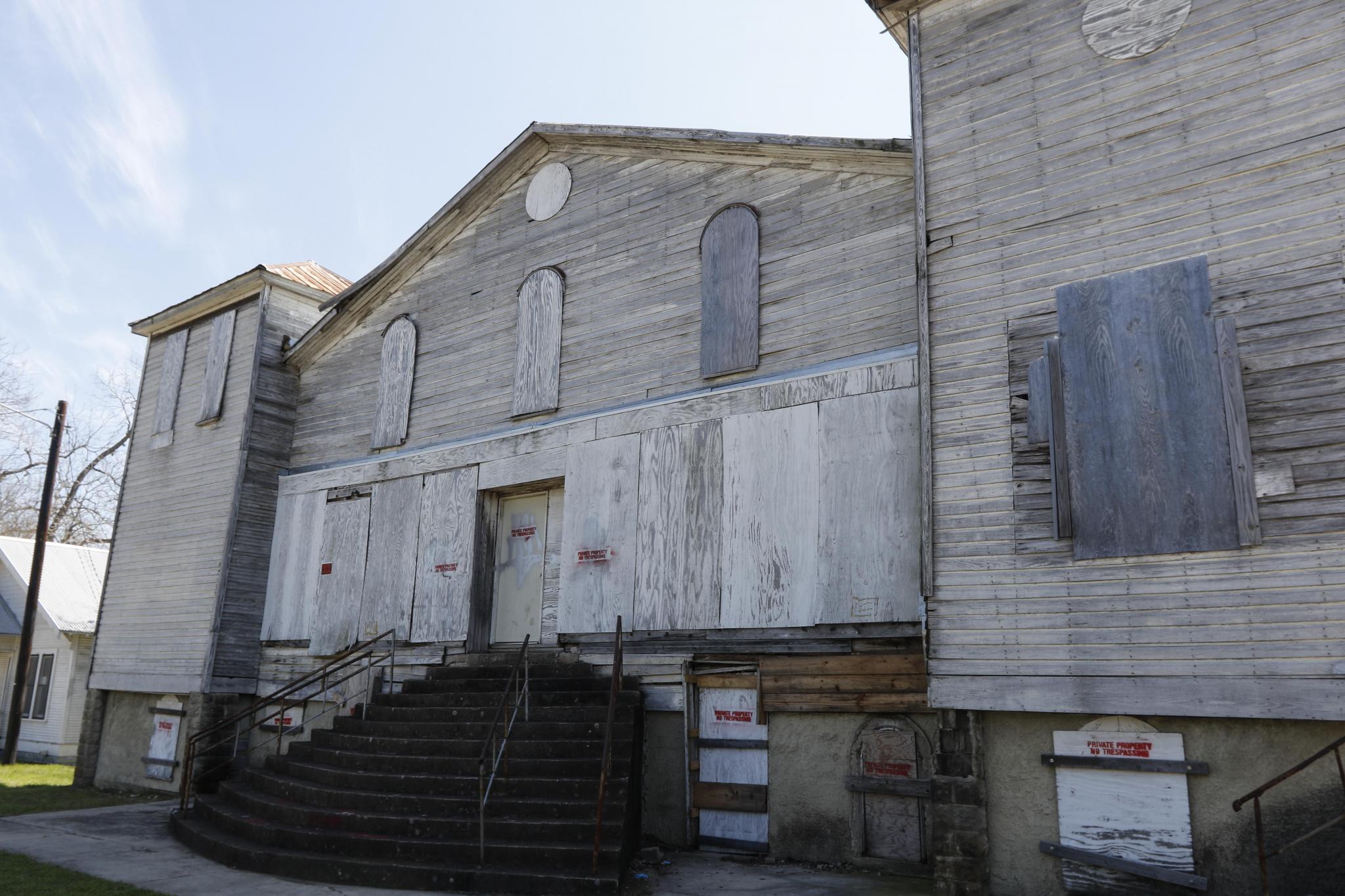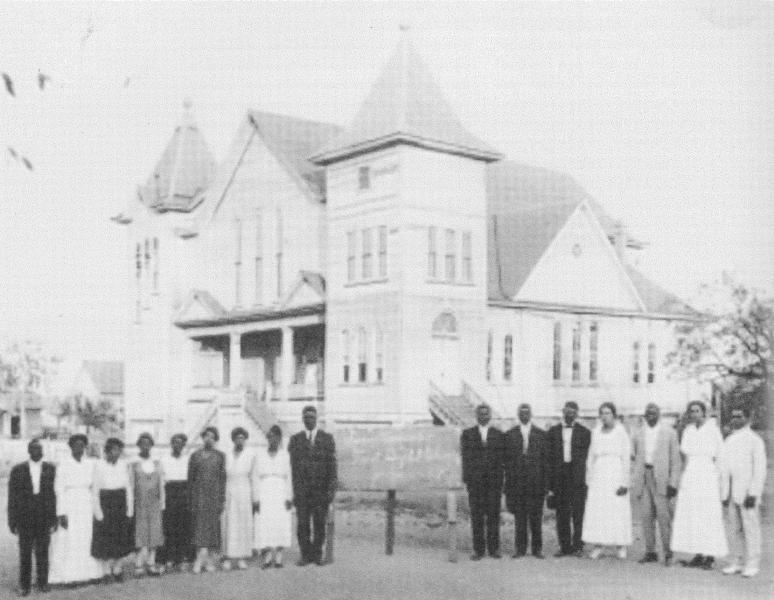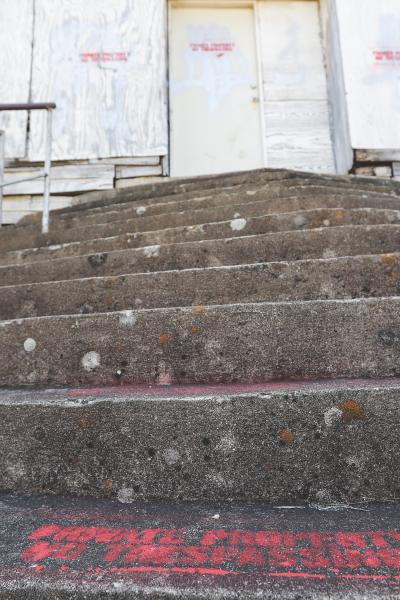
The First Baptist Church that stands on Martin Luther King Drive in San Marcos is 110 years old and a bastion of history for the San Marcos African-American community. Daily Record photos by Denise Cathey
'If these old walls could talk'
It is often said, “Oh, if this old building could talk, what stories it could tell.” Well, this old building can talk, so read my story and hear it as you read. I’m not that far removed from the slave era and some of my parishioners could have been in slave families as children.
I’m sitting here where I’ve been since 1908, when the first rhythms of life issued from my doors and windows. The old gospel songs rang through the streets of San Marcos and the rhythmic clapping of my occupants accompanied those tunes.
Look at the date. I’m 110 years old and still standing. But the hymns no longer ring from my doors and windows and the clapping of my first occupants, many of whom were freed by the (Texas) Emancipation Proclamation, is silenced.
Texas slaves waited two and a half years after their fellow slaves in other Confederate States celebrated their freedom. Lincoln issued the Proclamation on Jan. 1, 1863. It was not until June 19, 1865 – ergo our revered holiday, Juneteenth – that Texas slaves got the word from a Union Regiment that landed in Galveston.
So, you see, I was born just 43 years after the first Juneteenth. Most of my adult parishioners were very familiar with the slave era — first- hand experience of personal slavery or hearing reasonably current stories from their parents or grandparents.
To understand my concern about my age, and perhaps my future, go back to the stories your grandparents and maybe your great grandparents told you about cranking the Model T Ford by hand; pumping water and carrying it to the house in a bucket; cooking a meal on a wood burning stove. Today, technology has long ago made most of those activities and the equipment obsolete. About the only place you will find them is in a museum.
That, my young friends and maybe not so young friends, is not the case with me. I have already mentioned that I have a history. But unlike the Model T and the water well and the wood stove, I also have a future.

A photo of the congregation in front of the First Baptist Church taken several years after its construction. Photo courtesy of the San Marcos Public Library
I told you I was built in 1908. That’s the introduction to my past. There is much more. Why is 1908 significant? That’s the year the Hays County Courthouse was built. We are not that far apart in distance and age. And, we are not that far apart historically. You see my congregation was organized in 1866.
Churches were the most important, and often, the only means of organization for the slave and former slave. Quoting from “A Journey Through Time, A Millennium Edition,” a publication of the San Marcos Daily Record, “For decades The Old First Baptist Church played a vital role in the life and culture of the African Americans in the Dunbar Neighborhood as well as in the lives of a broad range of other people in San Marcos and vicinity. Erected in 1908 by the descendants of former slaves who organized the congregation in 1866, Old First Baptist is the oldest surviving public building in what was once the heart of African American Community in San Marcos.”
Ironically, the courthouse remains the central attraction of downtown San Marcos, even though almost all the Hays County legal and county business is conducted at the Government Center out on Stagecoach. I have fallen into disrepair and I have become what some might consider an eyesore, if you will. In fact, I am a narcoleptic's dream away from becoming scrap lumber.
As Kurt Waldhauser explains his involvement with the Old First Baptist Church: “In the fall of 2016, I had a contract on the building. Through my eyes, I saw income by tearing down the building and selling the lumber. As I discussed this idea with my wife, we began to see the building in a different light. There was just too much history in it, so we pulled out of the contract. However, my wife never let go of her idea. The spring of 2017, I had one of my weird dreams that narcoleptics have. I woke up and my mind was made up. I told my wife, ‘we have to do this.’ So, in April 2017, we bought the building. My visit with Ed Mihalkanin gave me a lot of the history of the building. That reinforced my determination to save the building.”
So you see, my friends, I have received a stay, a reprieve, maybe a pardon. Maybe one day, I’ll be restored to the honor and glory I once commanded.
I’m informed that Ollie Giles took the time to educate the man sitting behind the computer and recording all these stories. I’m further informed that she made him unmistakably aware of the fact that I could repeat my role as a community building. According to Giles, and I remember it also, many events of great significance were conducted under my roof.
From the unofficial voice of the Dunbar community, Ollie Giles: “We used the First Baptist Church for high school graduations, for large gatherings of all sorts and for Juneteenth. We had barbecues. When the crowds, i.e. funerals, weddings, graduations, special events were too large for other venues, the First Baptist Church was used.”
In the manner that is Ollie Giles’ trademark, she informed the author of this article, in no uncertain terms, that First Baptist Church Building — that’s me — is, in fact an iconic monument to an era that should never be forgotten.
I was fortunate enough to be located near the home of Ulyssis Cephas and had the chance to observe Mr. Cephas serve as a means of communication between the Klu Klux Klan and the Black community. It’s likely that there were times when his influence may have prevented the Klan from burning me to the ground, like the former church that housed my congregation was.

The concrete stairs have "Private Property No Trespassing" spray painted on the steps now, but a coalition of people and organizations from the community are actively advocating and working to restore the old building to its former glory.
Some of my members were former slaves and my presence had a tremendous impact on the Dunbar community. I came to be — that is, I was constructed in 1908 under the guidance of Reverend G.F. Curry. My congregations had been located in two or three locations until, I was constructed.
In 1927, I was remodeled under the guidance of Reverend J.C. Connally and again in 1953 under the leadership of Reverend C.M. Arnold. When I was remodeled the second time, major architectural changes were made. The ceiling was lowered and green siding was installed.
Verifying Ollie Giles’ claims of multiple uses of the Old First Baptist Church, the following quote from “A Program for the Historic District of San Marcos, Texas”:
“First Baptist greatly impacted the Dunbar neighborhood, surrounding the location of the church. According to the history of the First Baptist Church, it has played a vital role in the life and culture of African Americans in San Marcos and vicinity.
“It was not only a place for worship, but served as a school, theater, cafeteria and meeting grounds.”
So, as you read this, try to visualize me in my majestic days once again. And try to understand the influence I have had on the Dunbar community. And as Aretha Franklin’s death is memorialized nationwide, try to imagine her inimitable voice flowing from my windows and doors as another young woman gives us a mystic rendition of an old hymn, supported by the rhythmic hand clapping of a joyful congregation. That’s how Aretha began.
Author’s note: To participate in the effort to bring me back to life, a donation marked for the restoration of the Old First Baptist Church can be sent to the Calaboose African American History Museum at 200 Martin Luther King Dr., San Marcos, Tx 78666.











